|
Development
President opens Dikkowita harbour:
A new era dawns for fisheries industry
By Shirajiv SIRIMANE
An island nation such as Sri Lanka should not only be self-sufficient
in fish, but should actually be exporting its products. For the
Maldives, the number one foreign exchange earner is fish exports. This
has helped the tiny nation to boast a better per capita income than Sri
Lanka.
|
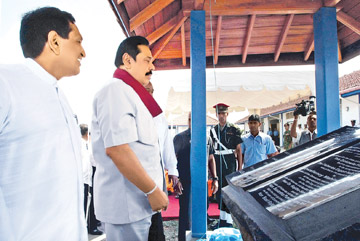
President Mahinda Rajapaksa at the Dikkowita Fisheries Harbour
opening. Fisheries and Aquatic Resources Development Minister
Rajitha Senaratne is also present. Pic:Chandana Perera |
The main reasons for Sri Lanka to fall back in this area was the
30-year terrorism, which put a halt to deep sea fishing, and lack of
fisheries harbours. With all fishing restrictions off, the fishing
industry can now make a big contribution to the national economy.
President Mahinda Rajapaksa, when he was Fisheries Minister,
identified another reason for the lack of progress in the fisheries
industry; the shortage of harbours to carry out fishing. After
identifying this crying need, he drew a plan to construct several
harbours, but they remained confined to plans since he did not get State
patronage to execute them.
Had these harbours been built at that time, the country would not be
paying high prices to import fish now; and it would have been a big time
fish exporter.
However, after Rajapaksa became President, he went ahead and started
building new fisheries harbours. In a bid to assist the Eastern
Province, President Rajapaksa built the Valachchenai harbour at a cost
of over Rs. 500 million; it was opened last month. It can accommodate
over 400 fishing vessels.
The new harbour consists of fuel stations, ice storage facilities,
refrigerators, deep freezers and adequate anchorage. The harbour
premises comprise 8.1 hectares of land and the harbour basin is around
11.7 hectares. The entrance to the harbour would be expanded to 70
metres from the present length of 50 metres.
Following this, President Rajapaksa also opened the Dikkowita
fisheries harbour on Friday with an investment of Euro 51 million; this
is the largest fisheries harbour in Asia.
The harbour will help increase the fish harvest due to efficient
handling operations.
Tax exemptions
|
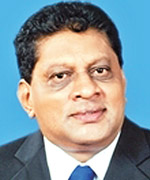
Lal Samarasinghe |
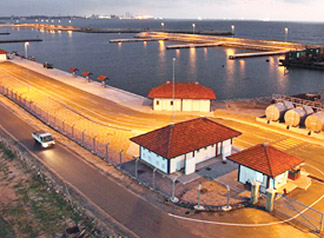
The Dikkowita fisheries harbour |
 |
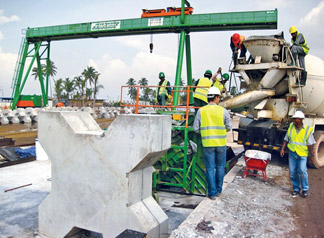
Construction under way at the harbour |
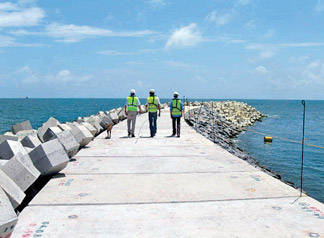
Entrance to the harbour |
The President said the fisheries industry was exempted from tax. “The
income derived from the fisheries industry is exempt from tax,” he said.
President Rajapaksa recollected how progressive governments led by
former Prime Ministers S.W.R.D. Bandaranaike and Sirimavo Bandaranaike
were committed to the uplift of the fisheries industry.
“Many fisheries harbours were developed in accordance with
international standards under the stewardship of Ministers Philip
Gunawardena and George Rajapaksa,” he said.
President Rajapaksa said the Government has established banks to
inculcate the savings habit among fishing communities.
He said the Government launched a housing program for fishing
communities living in shanties along the coastal belt. President
Rajapaksa was of the view that the children of fishing communities
should also have the opportunity for higher education and stressed the
need for creating a more conducive environment for this purpose.
The President said that the Ocean University was established with the
sole objective of upgrading the industry to professional standards.
The Dutch Government has provided Euro 53 million for the fisheries
harbour and BAM International was awarded the contract for the design
and construction of the fisheries harbour in Dikkowita situated near
Hendala.
The new fisheries harbour stands on an 8.1-hectare area and has 11.7
hectares for the harbour basin. It is designed to handle a catch of 125
tons of fish per day. It will reduce the sailing distance and waste due
to spoilage.
One of the unique designs of the harbour is two separate sections for
local and international fish operations.
The Dikkowita fisheries harbour will provide a large number of direct
and indirect employment opportunities and attract local and foreign
investments in fisheries, he said.
The harbour has an administration building, auction building, fish
processing units, six cool rooms, a net and glass fibre repair building,
a general store with firefighting equipment, crew amenities, a canteen,
fuel and water facilities and a slipway.
Fisheries and Aquatic Resources Development Minister Rajitha
Senaratne said this harbour will help increase the fish harvest due to
efficient handling operations.
“It will reduce the sailing distance and waste due to spoilage. The
Dikkowita fisheries harbour will provide a large number of direct and
indirect job opportunities and attract local and foreign investments in
fisheries,” he said. A special Project Implementing Unit (PIU) will
oversee the functions of the fisheries harbour on behalf of the
Fisheries and Aquatic Resources Development Ministry. “The fisheries
sector is Sri Lanka’s third most important contributor to economic
growth. It is second only to agriculture and tourism. The fisheries
industry will become the main contributor to the Sri Lankan economy
within the next few years. I hope to provide a 50 percent contribution
to Sri Lanka’s economy at the end of this year by doubling fish
exports”, Dr. Senaratne said.
Managing Director, Ceylon Fisheries Harbour Corporation, Lal
Samarasinghe said the Dikkowita harbour will provide direct access to
the sea for local fishermen who now have to use the Hamilton Canal and
the Negombo lagoon.
Many facilities
“We offer facilities for bunkering shipping vessels with four ice
plants, four cool rooms, and fuel sheds, a large fish processing area,
large canteen, a fish net repairing facility and remote-controlled boat
lifting facility. In addition, the facility would have a fish auction
hall, large canteen, parking for large containers and vehicles, net
mending facility and a special waste disposal system".
He said several international trawler operators from Japan and Europe
had already consented to bringing in fish caught from international
waters to Dikkowita for processing and then for re-export. They would
also use the harbour for bunkering, supplies, attending to repairs and
for many other services.
”The Bandaranaike International Airport is situated closeby and the
geographical location of the harbour is one of the biggest advantages
for them to select this harbour,” he said.
These trawlers could use the Southern terminal while the Northern
terminal would be allocated to local fishermen. Dikkowita is equipped
with modern conveyer belts to minimise post-harvest losses, thus
ensuring high quality exports.
The Dikkowita Fisheries Harbour would also help in accommodating
multi-day trawlers which were anchored in the Hamilton Canal and the
Negombo Lagoon. He said the project was a brainchild of President
Rajapaksa and this fills a great void in the country for the fishing
industry.
He said the future of the project would include a mini hotel for
overseas staff who arrive in trawlers to stay overnight, a can factory
and a large vessel repairing facility among other facilities. |



